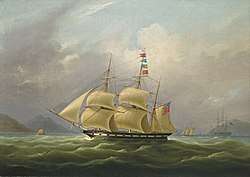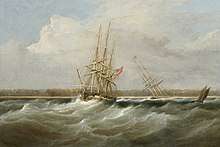Sylph (1831 ship)
Sylph was a clipper ship built at Sulkea, opposite Calcutta, in 1831 for the Parsi merchant Rustomjee Cowasjee.[2] After her purchase by the Hong Kong-based merchant house Jardine Matheson, in 1833 Sylph went on to set an unbroken speed record by sailing from Calcutta to Macao in 17 days, 17 hours.[2][3] Her primary role was to transport opium between various ports in the Far East.[4] She disappeared en route to Singapore in 1849.
 The opium clipper Sylph off Macao, circa 1838 by William John Huggins, she was owned by Mr. Alexander Robertson, supercargo for the firm of Jardine and Matheson | |
| History | |
|---|---|
| Name: | Sylph |
| Namesake: | Mythological creature in Western tradition, the Sylph |
| Owner: | Rustomjee Cowasjee |
| Builder: | Currie & Co., Sulkea, Calcutta[1] |
| Launched: | 1831[1] |
| Acquired: | Jardine Matheson, 1833 |
| In service: | 1832 |
| Homeport: | Hong Kong |
| Fate: | Disappeared en route to Singapore, 1849 |
| General characteristics | |
| Class and type: | Opium clipper |
| Tons burthen: | 304 (bm) |
| Length: | Hull, 100 ft (30.48 m) |
| Propulsion: | Sails |
| Complement: | 70 |
History
Sylph was designed in London by Sir Robert Seppings, surveyor of the Royal Navy, to the order of a consortium of Calcutta merchants headed by Rustomjee Cowasjee. Two contemporary paintings of Sylph show her to have been a heavily rigged ship with trysails on each mast and a tall, high-peaked spanker.[2]
Sleek, elegant, functional and devoid of ornament, Sylph did not have the rakish lines of the later clippers, yet proved to be particularly swift. She is supposed to have run from the Sandheads to Macao in sixteen days.[5]
In 1833 Jardines sent Sylph to explore the profitability of trading along the Chinese coast. Arriving at Macao in September, Sylph unloaded some of the opium she had transported from Calcutta and immediately departed northwards with the German Protestant missionary Karl Gützlaff on board as translator.[6] During the First Opium War (1839–1842) Jardines were offered a premium price for the ship, an offer that was declined on the basis of the huge profits she made from transporting opium.
Sylph and another well-known clipper, Cowasjee Family, were fitted out with extra guns and full European crews during the war, and were joined by the Lady Hayes, belonging to Jardine, Matheson & Co., the three ships sailing in company. While they were sailing among the islands Chinese war junks surrounded them and a fierce battle ensued. But Captains Wallace and Vice, of Sylph and Cowasjee Family, were two of the most experienced captains in the trade, celebrated for their daring and success in dealing with pirates, and the war junks suffered a severe defeat, many of them being sunk; after which the opium clippers had no more trouble.[5]

While sailing from Calcutta to China and carrying 995 chests of opium, Sylph ran aground on a shoal off the Malay Peninsula on January 30, 1835.[2][7] According to the Canton Register dated April 14, 1835, Captain Wallace told the vessel's insurers that she had been swamped, then beached by the northeast monsoon.[8] The East Indiaman Clive came to the rescue and the ship and all but two chests of opium were recovered.[2][7]
After undergoing re-rigging in Hong Kong in 1848 at a cost of 11,166.22 Mexican dollars, Sylph disappeared en route to Singapore the following year, possibly captured and burned by pirates based on Hainan Island.[2] Other sources believe that she was wrecked on the rocks of Pedra Branca off the coast of Singapore whilst carrying a cargo of opium to the value of 557,200 Spanish dollars.[9]
Citations
- Phipps (1840), p.113.
- Hunt 1999, p. 88.
- Denis Leigh (January 1974). "Medicine, the City and China". Med Hist. 18 (1): 51–67. doi:10.1017/s0025727300019219. PMC 1081522. PMID 4618583.
- "Opium Hall of Fame". Retrieved 13 October 2010.
- Lubbock, Basil (1914). The China clippers (2nd ed.). Glasgow: James Brown & Son. Retrieved 21 March 2013.
- Jason A. Karsh (2008). "The Root of the Opium War:Mismanagement in the Aftermath of the British East India Company's Loss of its Monopoly in 1834". Retrieved 13 October 2010.
- "(untitled)". The Times (15855). London. 30 July 1835. col A, p. 5.
- Canton Register (Vol. 8 No. 15), Tuesday, 14 April 1835 p. 62
- "Case Concerning Sovereignty Over Pedra Branca I Pulau, Batu Puteh, Middle Rocks and South Ledge" (PDF). 25 March 2004. Retrieved 14 October 2010.
References
- Hunt, Janin (1999). The India-China opium trade in the nineteenth century. McFarland & Company. ISBN 978-0-7864-0715-6.CS1 maint: ref=harv (link) Online version at Google Books

- Phipps, John, (of the Master Attendant's Office, Calcutta), (1840) A Collection of Papers Relative to Ship Building in India ...: Also a Register Comprehending All the Ships ... Built in India to the Present Time .... (Scott),
Further reading
| Wikimedia Commons has media related to Report on the 1835 beaching of the Sylph.. |
- Lubbock, Basil (1933). The Opium Clippers. Boston, MA: Charles E. Lauriat Co. Extensive coverage of Sylph's sailing career.